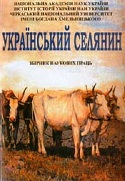Політична культура селянства в контексті революційних та державотворчих процесів у 1917-1921 рр.
##plugins.themes.bootstrap3.article.main##
Анотація
Мета статті полягає у тому, щоб дослідити, яким чином революційні та державотворчі процеси
періоду 1917-1921 рр. детермінувалися домінантами політичної культури українського сільського соціуму. Основними
завданнями статті є висвітлення та аналіз особливостей політичної свідомості селянства та обумовлених цими
особливостями форм соціальної поведінки селян і їх боротьби за реалізацію своїх соціально-політичних ідеалів, які
об’єктивно впливали на процеси державного будівництва революційної доби 1917-1921 рр. Висновки. Автором
зʼясовано, яким чином революційні та державотворчі процеси періоду Української революції 1917–1921 рр.
детермінувалися домінантними рисами політичної культури українського селянства. Висвітлено та проаналізовано
особливості політичної свідомості селянства та зумовлених цими особливостями форм соціальної поведінки селян,
які об’єктивно впливали на процеси державного будівництва революційної доби 1917–1921 рр. У статті зазначено,
щ о політична культура селян тісно пов’язувалася з громадсько-вічовими, козацькими за духом уявленнями про
державу та владу, які відзначалися егалітаризмом та демократизмом. Однак, це була демократія традиційного
суспільства з патріархальними вічовими елементами, яка орієнтувалася не на відтворення всієї державно-суспільної
вертикалі влади, а спрямовувалася переважно на нижній, сільський рівень адміністративно-територіального поділу.
Демократичне самоврядування розумілося селянам, як самоврядування сільської громади у вигляді сходу, як втілення
народовладдя у формі Рад. Тип народовладдя, що бачився селянами як система відносин, основаних на участі у
прийнятті рішень усіма представниками сільської громади або делегованими нею особами, можна кваліфікувати як
аграрну демократію.
##plugins.themes.bootstrap3.article.details##

Ця робота ліцензується відповідно до Creative Commons Attribution-NonCommercial 4.0 International License.
Посилання
Кornovenko, S. (2017) Sub’yektnyy skladnyk ahrarnoho pytannya yak odna z peredumov Ukrayinsʹkoyi revolyutsiyi 1917-1921.
[Subjective component of the agrarian question as one of the prerequisites of the Ukrainian revolution of 1917-1921]. Ukrayinsʹkyy
istorychnyy zhurnal. (Ukrainian Historical Journal). 4. 83-94. [in Ukrainian].
Kornovenko S. (2020) Khutirsʹka fi losofi ya P.Kulisha: bilya dzherel ukrayinsʹkoho ahraryzmu. [Farm philosophy of P. Kulish:
near the sources of Ukrainian agrarianism]. Ukrayinsʹkyy istorychnyy zhurnal (Ukrainian Historical Journal). 5. 64-76.[in Ukrainian]
Tsymbalistyy B. (1994) Tavro bezderzhavnosty. Politychna kulʹtura ukrayintsiv. [The brand of statelessness. Political culture of
Ukrainians]. Kyiv: Vyd. Vsesvit. Koordynats. Rady ta Resp. Asots. Ukrayinoznavtsiv. [in Ukrainian]
Nahorna A. (1998) Politychna kulʹtura ukrayinsʹkoho narodu: istorychna perspektyva i suchasni realiyi. [Political culture of the
Ukrainian people: historical perspective and modern realities]. Kyiv: Stylos. [in Ukrainian]
Rudakevych O. (1995) Mentalʹnistʹ i politychna kulʹtura ukrayinsʹkoyi natsiyi. [Mentality and political culture of the Ukrainian
nation]. Rozbudova derzhavy (State building).10. 26-30. [in Ukrainian]
Osnovy etnoderzhavoznavstva (1997) [Fundamentals of ethnostate studies]: [za red.YU.I.Rymarenka]. Kyiv: Lybidʹ. [in Ukrainian]
Hrushevsʹkyy M. (1991) Na porozi novoyi Ukrayiny: Hadky i mriyi. [On the threshold of a new Ukraine: Misconceptions and
dreams]. Kyiv: Naukova dumka. [in Ukrainian]
Kappeler A. (1992) Struktura ukrayinsʹkoho natsionalʹnoho rukhu v Rosiysʹkiy imperiyi. [The structure of the Ukrainian national
movement in the Russian Empire]. Suchasnistʹ. (Modernity).7. 48-56. [in Ukrainian]
Hrytsak Y. (1996) Narys istoriyi Ukrayiny. Formuvannya modernoyi ukrayinsʹkoyi natsiyi ХІХ-ХХ st. [Essay on the history of
Ukraine. Formation of the modern Ukrainian nation of the XIX-XX centuries]. K.: Geneza. [in Ukrainian]
Kryzhanivsʹka O. (2007) Sotsialʹni nastroyi ta uyavlennya selyan Pravoberezhnoyi Ukrayiny u 20-50-kh rr. ХІХ st. [Social moods
and ideas of the peasants of the Right Bank of Ukraine in the 20-50s of the XIX century]. Ukrayinsʹkyy istorychnyy zhurnal (Ukrainian
Historical Journal). 2. 130-142. [in Ukrainian]
Klybanov A. (1978) Narodnaya sotsyalʹnaya utopyya v Rossyy. [People’s social utopia in Russia]. Moskva: Nauka. [in Russian]
Visty z Ukrayinsʹkoyi Tsentralʹnoyi Rady (News from the Ukrainian Central Council). (1917). Travenʹ. May. 60. [in Ukrainian]
Ukrayinsʹkyy natsionalʹno-vyzvolʹnyy rukh. (2003). Berezenʹ-lystopad 1917 roku. Dokumenty i materialy [Ukrainian national
liberation movement. March-November 1917. Documents and materials]. Edited by: V. Verstyuk (manager) and others. Kyyiv.
Vydavnytstvo imeni Oleny Telihy (Elena Teliga Publishing House). [in Ukrainian]
Tsentralnyi derzhavnyi arkhiv vyshchykh orhaniv vlady i upravlinnia Ukrainy [Central State Archive of the highest authorities and
administration of Ukraine – CSAHAAU], Fund 1327, Inventory 1, File 76. Ark.17. [in Ukrainian]
CSAHAAU, Fund 1115, Inventory 1, File 54, Ark. 3, 15. [in Ukrainian]
Hryhoriyiv N. (1941) Ukrayinsʹka natsionalʹna vdacha. [Ukrainian national character]. Vinnipeh: Vydannya Ukrayinsʹkoyi
vydavnychoyi spilky v Kanadi. [in Ukrainian]
Shvetsova A. (1999) Natsionalʹnyy kharakter yak fenomen kulʹtury. [National character as a cultural phenomenon]. Simferopolʹ:
«Tavriya». [in Ukrainian]
Derzhavnyy arkhiv Kyyivsʹkoyi oblasti [State Archives of Kyiv Region]. Fund. R-2796, Inventory 1, File 16. [in Ukrainian]
Farenii I. (2014) «Natsionalʹnyy ukrayinsʹkyy trest»: spozhyvcha kooperatsiya Ukrayiny v roky revolyutsiyi ta hromadyansʹkoyi
viyny (1917-1920). [ «National Ukrainian Trust»: consumer cooperation of Ukraine during the revolution and civil war (1917-1920)].
Cherkasy: Vertykalʹ, vydavetsʹ Kandych S.H. [in Ukrainian]
Prysyazhnyuk Yu. (2002) Ukrayinsʹke selyanstvo ХІХ-ХХ st.: evolyutsiya, mentalʹnistʹ, tradytsionalizm. [Ukrainian peasantry of
the XIX-XX centuries: evolution, mentality, traditionalism]. Cherkasy: «Vidlunnya-Plyus». [in Ukrainian]
Bevz T. (2003) Narodovladdya yak systema ukrayinsʹkoho derzhavotvorennya (za tvorchym spadkom N.Hryhoriyeva). Podiyi i
osobystosti revolyutsiynoyi doby. [Democracy as a system of Ukrainian statehood (according to the creative heritage of N. Grigoriev).
Events and personalities of the revolutionary era]: zbirnyk. Kyiv: IPiEND.164-204. [in Ukrainian]
Visti Kamʺyanetsʹkoho povitovoho ispolnitelʹnoho komiteta. (News of the Kamenets County Executive Committee). (1917). 3. 5. 2.
Oct. 14, 1917. №40; 4. 8. 1917. №3.3. 5. 1917. № 2. 23.
Narodnye slovo. (The people’s word). (1917). 14. 10. 40; Prylutsʹka dumka. (Pryluky thought). (1917). 4. 8. 3.
CSAHAAU, Fund 538, Inventory 1, File 107. [in Ukrainian]

